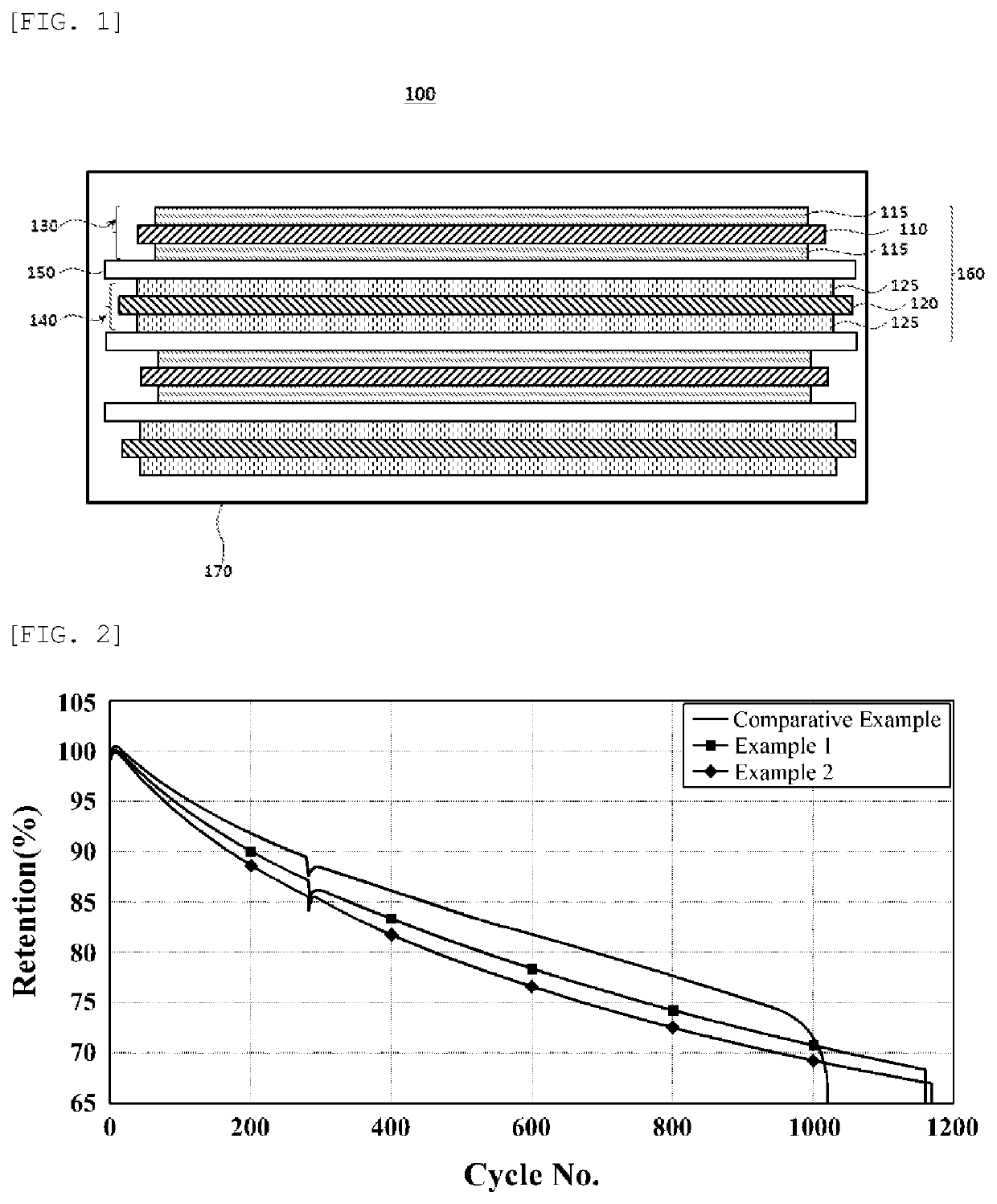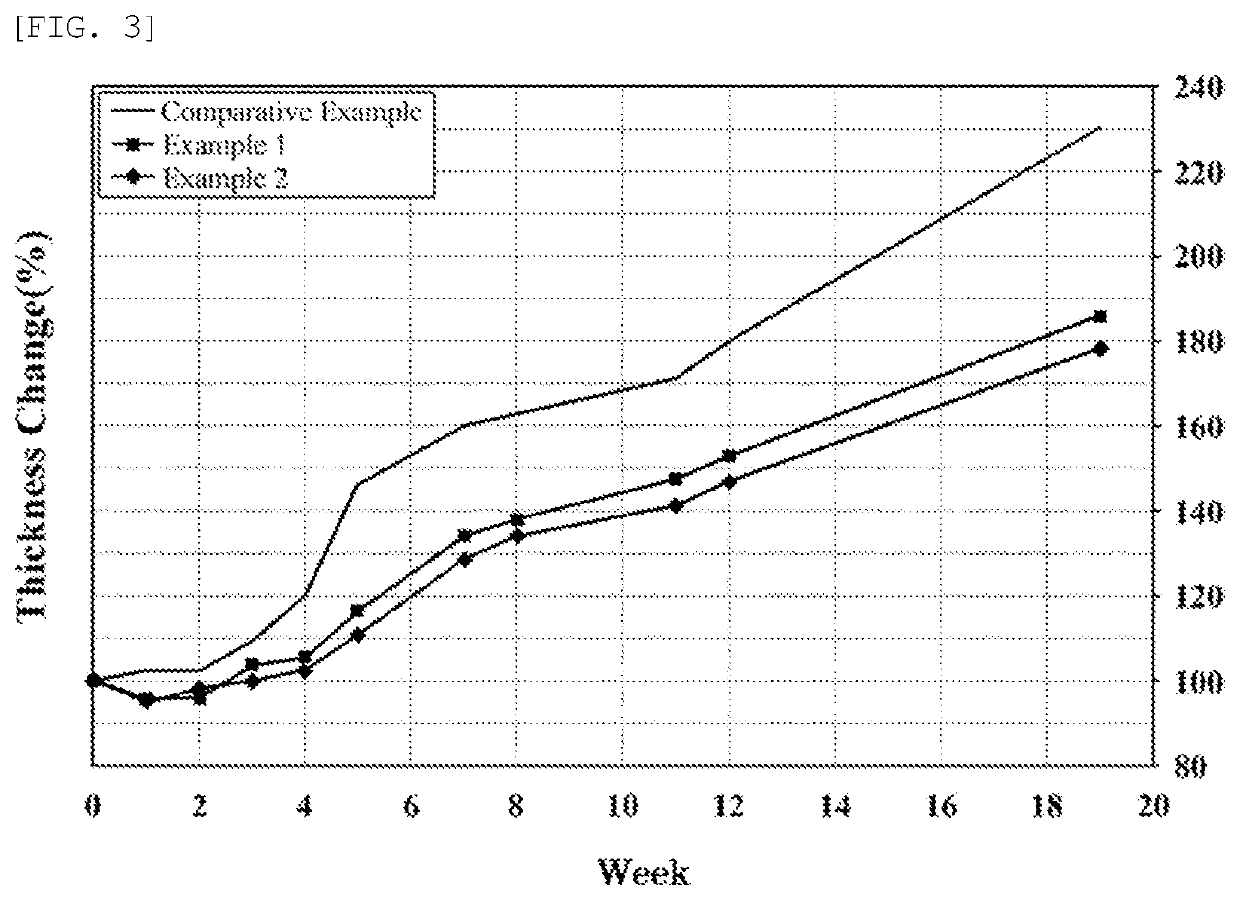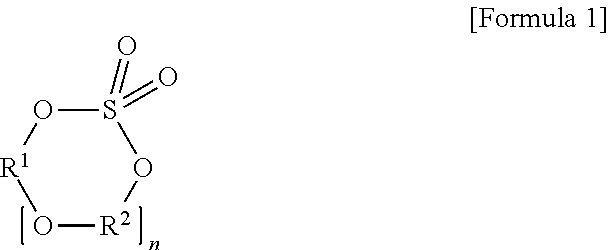Electrolyte for Lithium Secondary Battery and Lithium Secondary Battery Including the Same
- Summary
- Abstract
- Description
- Claims
- Application Information
AI Technical Summary
Benefits of technology
Problems solved by technology
Method used
Image
Examples
examples 1 and 2
[0096]Electrolytes of Examples 1 and 2 were prepared by adding 0.5 wt. % and 1 wt. % of a compound represented by Formula 2 below based on the total weight of the mixed solvent to the reference electrolyte solution prepared in the comparative example.
Preparative Example: Preparation of Secondary Battery
[0097]A slurry was prepared by mixing Li[Ni0.6Co0.2Mn0.2]O2 as a cathode active material, carbon black as a conductive material, and polyvinylidene fluoride (PVdF) as a binder in a weight ratio of 92:5:3. The prepared slurry was uniformly applied to an aluminum foil having a thickness of 15 μm, and is vacuum-dried at 130° C. to prepare a cathode for a lithium secondary battery.
[0098]An anode slurry, which include 95 wt. % of silicon graphite composite (SiC) containing silicon in an amount of 10 wt. % as an anode active material, 1 wt. % of Super-P as a conductive material, 2 wt. % of styrene-butadiene rubber (SBR) as a binder, and 2 wt. % of carboxymethyl cellulose (CMC) as a thickene...
experimental example 1
n at Room Temperature
[0100]Discharge capacities were measured by repeatedly charging (CC / CV 1C 4.2 V 0.1 C CUT-OFF) and discharging (CC 1 C 2.7 V CUT-OFF) the manufactured secondary battery at about 35° C., then capacity retention rates were calculated as a percentage after performing charging / discharging cycles multiple times compared to initial discharge capacity, and results thereof are shown as a graph in FIG. 2.
[0101]Referring to FIG. 2, in the case of the comparative example, it was confirmed that the capacity retention rate is rapidly decreased after about 1,000 times of charging and discharging, but in the case of the examples, it was confirmed that the capacity was maintained at an appropriate level even up to about 1,200 times of charging and discharging.
experimental example 2
perature Storage Characteristics
[0102]The manufactured secondary batteries were placed in a chamber at 60° C. for 4 and 6 weeks, and then left at room temperature for 30 minutes.
[0103](1) Evaluation of Capacity Retention Rate
[0104]The left secondary batteries were charged (CC / CV 1 C 4.2 V 0.1 C CUT-OFF) and discharged (CC 1 C 2.7 V CUT-OFF), and the discharge capacities were measured, then capacity retention rates were calculated as a percentage compared to the initial discharge capacity at room temperature, and results thereof are shown in Table 1 below.
[0105](2) Evaluation of Thickness Change of Anode
[0106]Thicknesses of the anode after storage at high temperature were measured, and thickness change rates were calculated as a percentage compared to the initial thickness of the anode, and results thereof are shown in Table 1 below.
TABLE 1Storage for 4 weeksStorage for 6 weeksCapacityThicknessCapacityThicknessretentionchangeretentionchangeSectionrate (%)rate (%)rate (%)rate (%)Compa...
PUM
 Login to View More
Login to View More Abstract
Description
Claims
Application Information
 Login to View More
Login to View More - R&D
- Intellectual Property
- Life Sciences
- Materials
- Tech Scout
- Unparalleled Data Quality
- Higher Quality Content
- 60% Fewer Hallucinations
Browse by: Latest US Patents, China's latest patents, Technical Efficacy Thesaurus, Application Domain, Technology Topic, Popular Technical Reports.
© 2025 PatSnap. All rights reserved.Legal|Privacy policy|Modern Slavery Act Transparency Statement|Sitemap|About US| Contact US: help@patsnap.com



